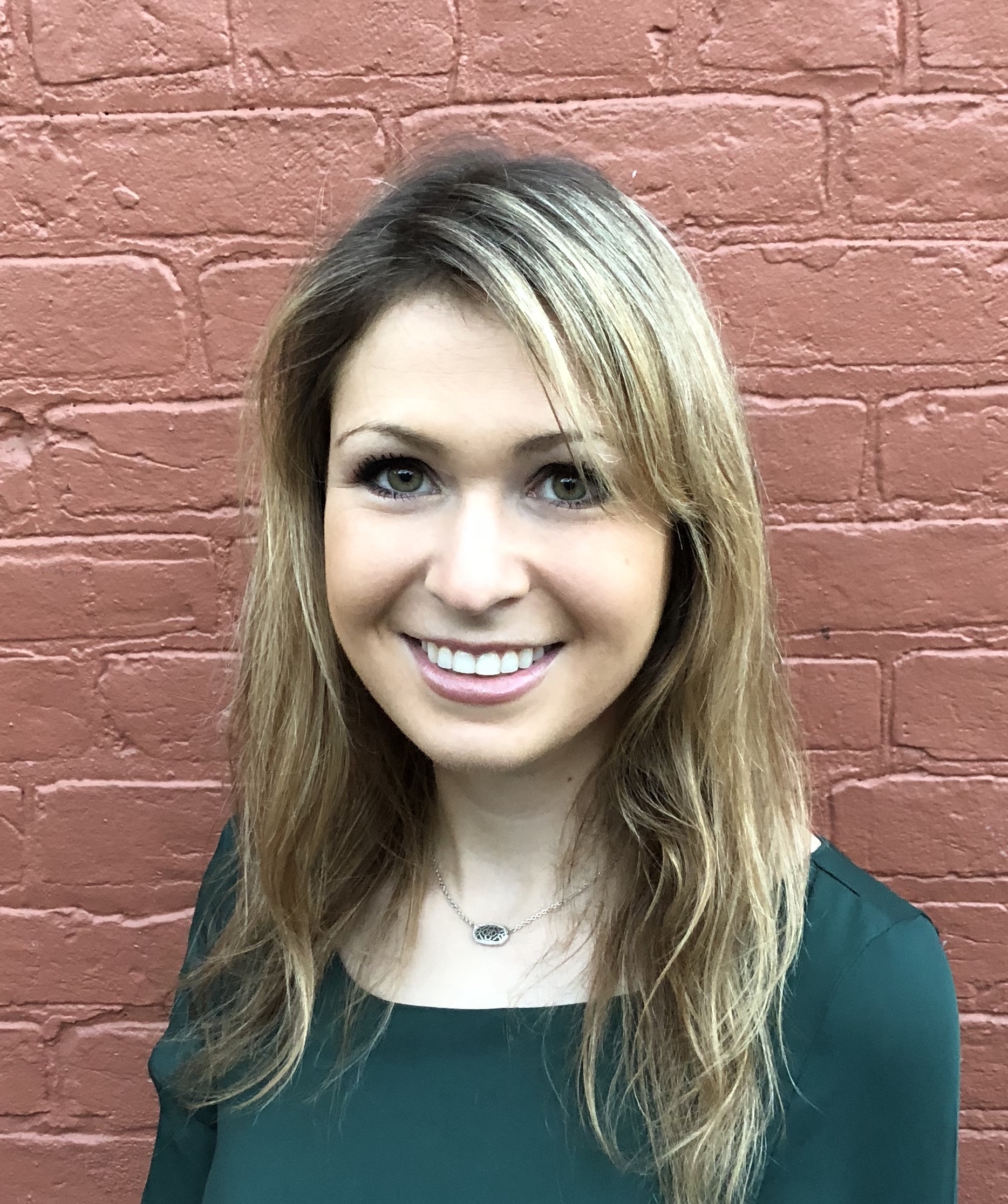
By MIRIAM ACZEL
On October 4th, 2018, Leaders in Energy (LE), in partnership with Resilient Virginia, held its “Utilities of the Future Forum” at the US Navy Memorial in Washington DC. The event had over 80 attendees and was an exciting opportunity to look at recent developments in the role of utilities and future of energy provision and new changes.
Leaders in Energy, Founder and Executive Director and session co-moderator, Janine Finnell, kicked off the event, introducing the three panelists from the Edison Electric Institute (EEI), the MIT Energy Initiative (MITEI) and the Environmental Defense Fund (EDF). She also thanked the event sponsors, which included EEI,eSai, LLC, and WethePizza.

Janine discussed how these are exciting times in the power sector with many developments taking place with new energy technologies, new business and regulatory models, the development of more level playing fields for centralized and decentralized systems, and work taking place to make the grid more resilient and low-carbon.
A number of states are moving aggressively in this direction. California recently passed a law that will make their grid 100% carbon free by 2045. Similar initiatives are taking place in New York. In Washington, DC, legislation is underway to develop a Distributed Resources Authority to make the grid more resilient. The 2018 Maryland Clean Energy Summit also took place the following week on grid resilience.
Janine highlighted a couple of reports to set the stage. The first was the International Energy Agency’s World Energy 2017 Outlook. The IEA, based in Paris, is well-respected for their statistics and analyses of global energy use. IEA points to the need to make transformative changes in the energy sector. The IEA examined a number of scenarios related to energy and climate emissions, including the “New Policies Scenario” and the “Sustainable Development Scenario.” The New Policies scenario was striking because their projections included the current commitments of countries under the Paris Climate Treaty. Even so, global CO2 emissions and energy demand continues to rise with the equivalent of adding another India and China to global energy demand between now and 2040. In the Sustainable Development Scenario, renewables, energy efficiency, and other technologies including nuclear and carbon capture, are used for decarbonization and increased electrification to get a radical reduction in CO2 emissions. IEA is recommending pursuing this latter route.

In addition, Janine cited a new Climate Economy report titled “Unlocking the Inclusive Growth Story of the 21st Century,” published by the Global Commission on the Economy and Climate that discusses the great potential for creating $26 trillion in new economic gains by accelerating the transition to a better, more inclusive new climate economy in 5 key economic systems: energy, cities, food and land use, waste, and industry including the circular economy (which Leaders in Energy is focused on).
Annette Osso, Managing Director, Resilient Virginia and co-moderator for the session, highlighted the importance of electric power and exploring ways to improve the power grid and accelerate action on resiliency in communities.

Utilities of the Future: Speaker Highlights
John Caldwell, Edison Electric Institute (EEI)
The first speaker, John Caldwell, Ph.D., Director of Economics at the Edison Electric Institute (EEI), began his presentation by describing the importance of a commitment to a cleaner economy. Distributed energy resources will play an important role in this transition, and their growth trend in recent years has been very significant.

Caldwell reported that we’re seeing a total electric retail evolution, with three distinct phases. The first phase is a stage where all utilities are undergoing comprehensive grid modernization—incorporating communications technologies, information technologies (IT), and developing devices and mechanisms to enhance knowledge regarding consumption such as smart meters.
 The second stage is more dependent on the regulatory regime: Caldwell opined that when “5% of our energy is coming from non-utility sources, we’ll have to rethink our regulations” in the face of the changing nature of the sources of energy. For example, Hawaii currently has roughly 23% penetration of energy provision from non-utilitysources.
The second stage is more dependent on the regulatory regime: Caldwell opined that when “5% of our energy is coming from non-utility sources, we’ll have to rethink our regulations” in the face of the changing nature of the sources of energy. For example, Hawaii currently has roughly 23% penetration of energy provision from non-utilitysources.
The third phase is when we move beyond optimization—when we get to a point with “over 30% penetration of non-utility sources of energy, we’ll need to rethink how the market is organized.” Caldwell concluded that at the stage where over 30% of our power is from non-utility sources, we will need market mechanisms to enhance and act in conjunction with this changing dynamic—the energy market “won’t be like a wholesale market, but rather, there will always be a need for some entity ensuring that everyone is getting enough power.”
Caldwell continued that the “transactive grid allows consumers to move beyond having a passive role” (there either is energy or there is not) to taking a more active role and thinking more about what this actually means. As the nature of the grid continues to evolve, we can think about how to sell energy back to the grid when prices are high—and therefore move towards more energy used when morelower-cost energy is available. He also explained that the “next dimension would be location-based,” where the location of distributed energy resources on the grid will impact how they are priced. However, even in this second phase, customers and distributed energy resource providers would still be dealing with a central intermediary, analogous to the stock exchange. The most challenging dimension, if and when it becomes a reality, would be the enabling of peer-to-peer transactions.
Will Customers Want Distributed Resources?
Caldwell explained that, indeed, “as long as the lights are on,” customers would be fine with distributed energy resources.

Cyber as the Elephant in the Room
Caldwell concluded by explaining that cybersecurity and the threat of cyber-attacks is the “elephant in the room: while some argue that smart grids can make our electric grid systems moreresilient, others argue that this very nature, the increasingly interconnectedness of our grid systems, makes us more vulnerable.” So, while there is great potential in connecting telecommunications and other technologies to our energy systems—think, using Alexa or Google Home for electric vehicle charging, or determining that you want your AC or heating systems on only when electricity prices are low–we need to think about how to ensure resilience and reduce potential vulnerability.
Cyril Draffin, Massachusetts Institute of Technology’s Energy Initiative (MITEI)
 Cyril Draffin, project advisor to Massachusetts Institute of Technology’s Energy Initiative (MITEI) next spoke on findings from the MITEI’s recent report, “Utility of the Future.” Draffin explained that MITEI is working on implementation of a series of low-carbon energy centers and initiatives. He discussed the exciting work at MIT developing the potential for energy from nuclear fusion, harnessing the power of a “plasma hotter than the sun.”
Cyril Draffin, project advisor to Massachusetts Institute of Technology’s Energy Initiative (MITEI) next spoke on findings from the MITEI’s recent report, “Utility of the Future.” Draffin explained that MITEI is working on implementation of a series of low-carbon energy centers and initiatives. He discussed the exciting work at MIT developing the potential for energy from nuclear fusion, harnessing the power of a “plasma hotter than the sun.”
Draffin also discussed some of the key findings from the MITEI report, including the need for “locational energy pricing,” for energy services, rather than flat volumetric tariffs. He explained energy prices at the transmission level may vary significantly if there are network constraints, and it’s better to deploy incremental distributed energy resources in locations where energy prices are high. He continued that while locational energy pricing can be complex to develop, improved regulations “need to become more sophisticated and more complex, to match the changing nature and increased complexity of the grid.”
Draffin also spoke about the interesting balance “between the need for renewable energy, which is great for decarbonization, and distributed energy resources, which are great for energy cost efficiency if sited in appropriate decentralized locations.” He continued, you can’t “conflate renewable energy and distributed energy”—and many renewable resources can be deployed in a distributed or centralized form. He indicated centralized utility solar farms in Southwestern US are more cost effective (excluding tax credits) than residential solar in the Northeast US, in part because of differences in solar “insolation” and economies of scale.
So, how do you deal with these issues? Draffin explained that one solution is to use “price signals closer to real time,” peak-coincident capacity charges, and consideration of resiliency “if you want to operate more efficiently and reliably.”
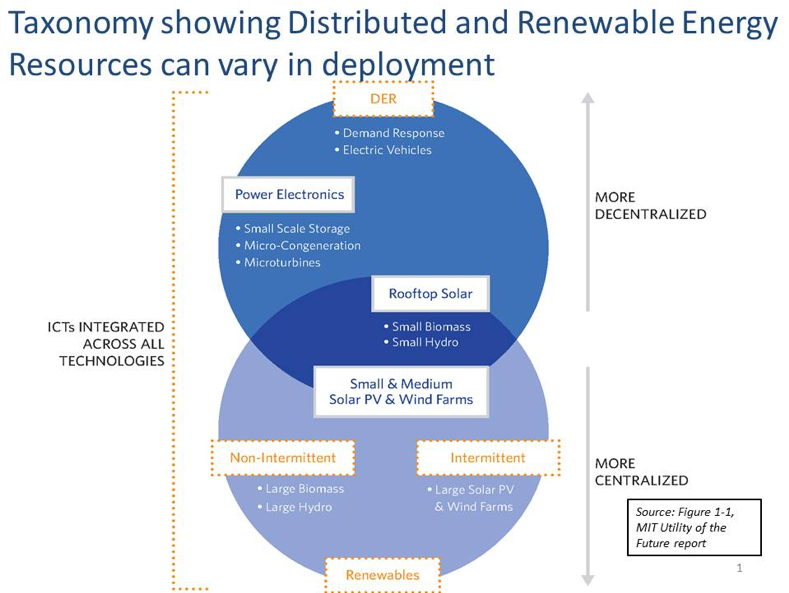
Elizabeth Brooke Stein, the Environmental Defense Fund (EDF)’s Clean Energy Program
The third and final speaker was Elizabeth Brooke Stein, an attorney in the Environmental Defense Fund (EDF)’s Clean Energy Program, with a focus on development of a low-carbon energy system. Stein’s presentation was related to her role as the lead author of the EDF’s whitepaper titled “Driving Environmental Outcomes Through Utility Reform: Lessons from New York REV,” a roadmap for electric utilities looking to accelerate decarbonization—or elimination of fossil fuels.
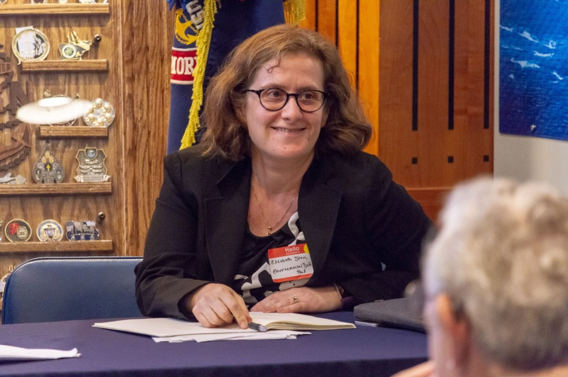
Stein began by discussing the White Paper and New York’s efforts to reform the state’s utility regulations (Reforming the Energy Vision, or REV), and the various technological enhancements that make this renewable transition possible. For example, technology has matured on both the consumer side and on the grid side.
Stein then presented a few key aspects of New York’s REV vision as identified in the paper, such as the fact that “utilities need to take into account the social costsof energy generation” in addition to financial costs. She also explained that the full value of energy efficiency includes reduced need for energy and pollution avoidance as well as the value of reducing stress on the electric grid.
Stein continued that New York’s definition of “distributed energy resources” is “actually super broad: for example, anything that changes what energy consumption looks like, such as an electric vehicle in your garage, with the potential to store energy, or solar panels that generate energy, or even energy efficiency” can be considered a distributed energy resource in New York.
So, how can utilities thrive in this changing future? Stein discussed the notion that a utility can—and according to the New York Public Service Commission should strive to “be like Amazon, or a broker, that makes money from the transactions that are going on within its platform”—this is the gold standard for operating as a platform business. So how can you get utilities to wantto develop efficient platforms? Stein explained that until Platform Service Revenues are available at scale, other earnings opportunities are possible for them, such as compensation for relying on Non-Wires Alternatives and Earnings Adjustment Mechanisms for achieving public policy goals.
Stein also explained that with traditional mass market rates consumers don’t see the difference between the cheapest electricity and the most expensive – and in New York “the most expensive power tends to be dirtyenergy.” So pricing that is closer to real time pushes customers toward cleaner energy. And, if you pair “real time pricing with a price or fee on carbon, you are really fast-tracking to an environmentally efficient mechanism.” For example, New York may soon subject generators to a higher price on carbon emissions. Together with real-time pricing this could give customers a very strong environmental signal. However, since electrification is extremely important to decarbonization, it is also important when incorporating the social costs of carbon in electricitypricing not to neglect to charge or incorporate the social costs in other energy types such as gasoline.
Stein also touched on New York’s new compensation approach for distributed renewable generation, which is known as the value stack. The value stack, which is mainly designed for community distributed generation that isn’t on the same premises as the energy consumers who own it, is based on the sum of the values that the resource provides: wholesale energy value, distribution system avoidance value, and environmental value. Because the sum of these values is typically lower than the per-kWh retail cost of electric service under traditional mass market pricing, New York regulators provided for a “Market Transition Credit” that smoothed the transition from an amount that would be equivalent to the compensation that was traditionally available for distributed generation located at customers’ premises.
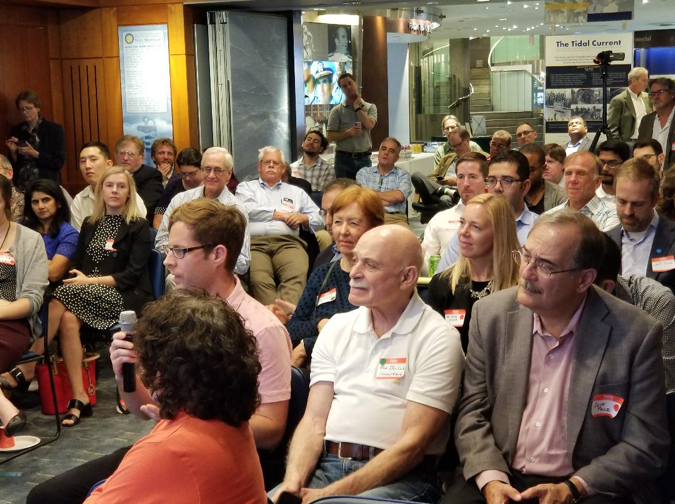
Panel Conclusion
The panel concluded with a question and answer session. The audience was clearly excited about the recent developments in the changing nature of the electric grid, and could easily have stayed all night! The three panelists were asked several questions from the engaged audience, including: “What’s next? Are there enough incentives for utilities to make these necessary changes?”
Caldwell summed up the evening, stating that “a lotneeds to be done by regulators. Utilities are contending with a business model that needs to be changed—we’re reached a saturation point. Following a period of phenomenal growth in utilities in the 1950’s and 1960’s, and continuing to a leveling of electricity demand in the 1970’s, we’re currently looking at a period of no growth or even decline in electricity demand” and continued reliance on fossil energy. The time for regulators to act is now.
Janine concluded the lively evening with a raffle drawing, and gift cards for two lucky winners, and left time at the end of the event for additional networking and refreshments.
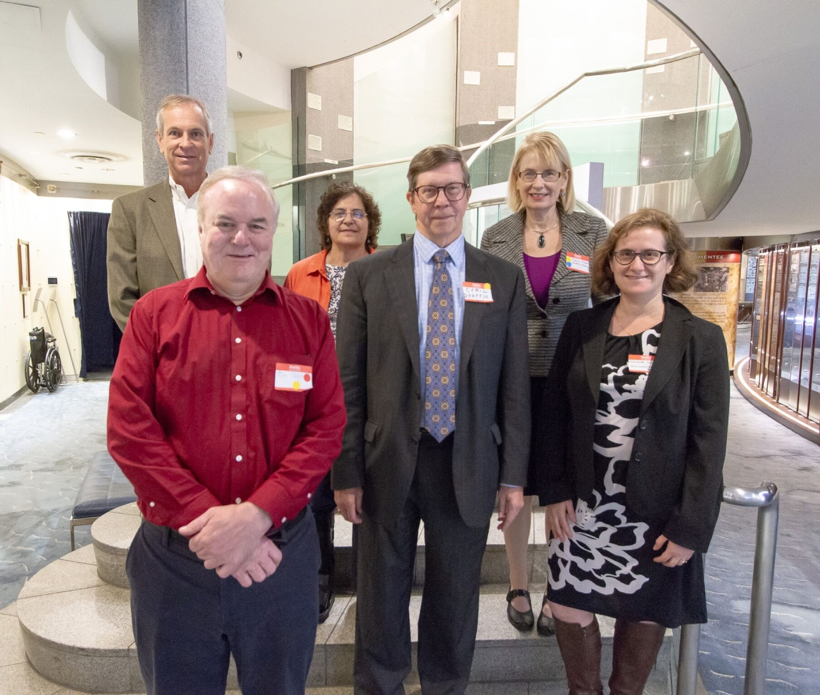
Figure 1: Front Row (l-r(: John Caldwell, EEI; Cyril Draffin, MIT; and Elizabeth Stein, EDF; second row, Vestal Tutterow, Resilient Virginia Board, Annette Osso, Managing Director, Resilient Virginia, and Janine Finnell, Leaders in Energy
Miriam Aczel is a President’s Scholar PhD Candidate at Imperial College London’s Centre for Environmental Policy. Her research focus is on international energy science and policy, with a focus on mitigation of environmental and health impacts of shale gas. She is also co-founder and co-director of the Amir D. Aczel Foundation for Research and Education in Science and Mathematics, a nonprofit based in Cambodia.
Miriam is Director of Communications and blog editor for Leaders in Energy.



Leave a Reply